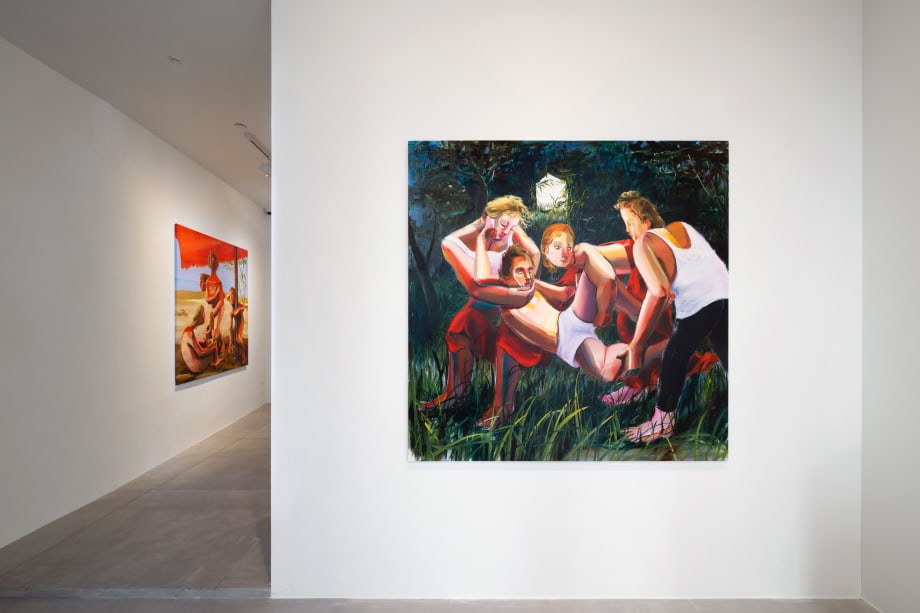Double Q Gallery is delighted to present Five Deep Breaths, a solo exhibition of new works by Budapest-based artist Luca Sára Rózsa. Rózsa’s recent paintings are often inspired by stories preserved in the collective memory of Judeo-Christian culture, through which she examines questions, common to both Eastern and Western philosophy, concerning the role of the individual within the cycles of the world. While travelling in Asia, she became fascinated by the idea rooted in ancient Eastern thought that human existence and the place and role of human beings in society are links in an eternal cycle. By contrast, individual existence in Western culture is determined by self-centredness, and a person’s life and actions are governed by the quest for self-fulfilment.
Rózsa’s latest paintings can be divided into two types in terms of their composition and the figures they depict: the two paintings that open and close the exhibition, Enter (Leave) and Leave (Enter), feature scenes integrated within the natural environment that are inspired by the Pietà and depictions of birth in Christian iconography. Placed between these two multi-figure paintings that represent the beginning and end of life are five compositions depicting individual figures, likewise in natural settings, engaged in enigmatic activities – hanging from a tall tree (Find Your Home), fleeing with a white flag (Runner [Wind Blown Eyes]), stranded in a swamp (Stillness of the Forest), or sitting in contemplation on the edge of a cliff (The One with a Tan Turning Away From Infinity). The often-monumental figures become part of the landscape that surrounds them, here solitarily, and on other occasions in larger groups.
In most cases, however, the sense of spatiality within Rozsa’s compositions are not created by the line of the horizon: she does not typically divide her landscapes into the duality of above and below. The dynamically painted, lush natural environment, and the flesh-toned, androgynous figures within it are rendered in dense, overlapping brushstrokes. This engenders a sense of timelessness, while the religion, race, and personal traits of the depicted figures are likewise indeterminate. However, the abstraction of the human body’s anatomical proportions has an explicit goal: the artist herself has stated that her images reflect on philosophical, metaphysical, and existential questions that are, in themselves, abstract. The smallest painting, Self-portrait with Golden Glow, is an exception among the single-figure compositions. Here, the artist has painted herself in infinite space and time, bathed in an otherworldly light.
Timelessness does, however, allow the artist to fall back on the responses provided by evolution, philosophy, the biblical Creation story, posthumanism, and even ecology when examining the “beginning” and “end” of the universe and the cycles of the world. Besides paintings, the exhibition features a second group of works – an installation of ceramic sculptures mounted on pedestals, You Start Where I End. The fragments look like ancient sculptural findings, making it hard to decide whether they are pieces from a collection of relics left behind by a lost human civilisation, or specimens on the workbench of some posthuman geologist, containing traces and vestiges of the death and disappearance of humanity. The wheatgrass growing from within them symbolises the recurring cycle of birth and death in the eternal flow of the world. Wheatgrass is one of the most important plants in Christian culture: it sprouts from a seed, vibrant with new life, and grows into a tender shoot. It then withers from green profusion, after which its residue enrich the soil that feeds the beginnings of new life in the ecosystem.
— Mónika Zsikla

